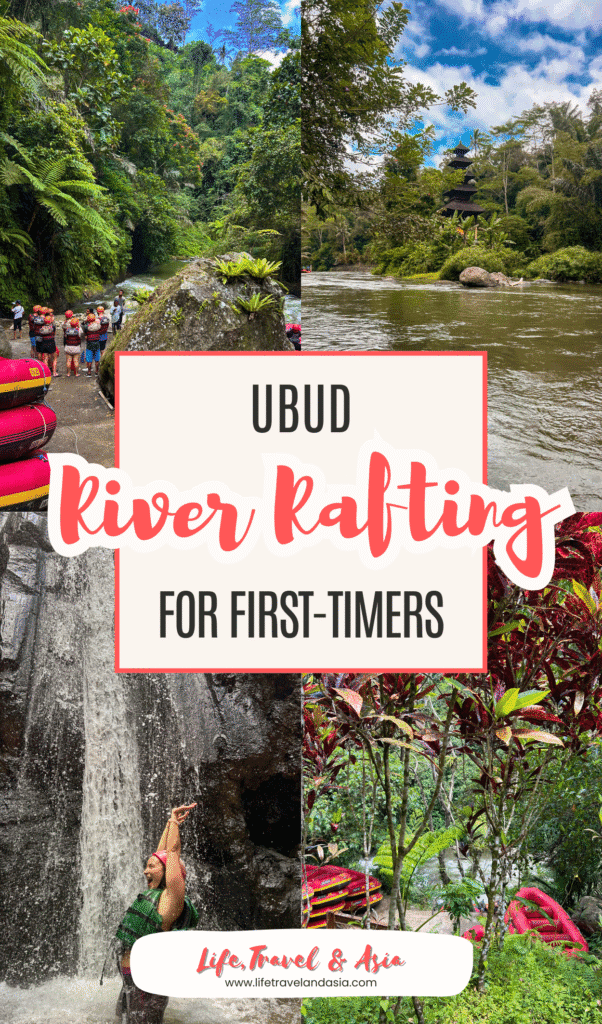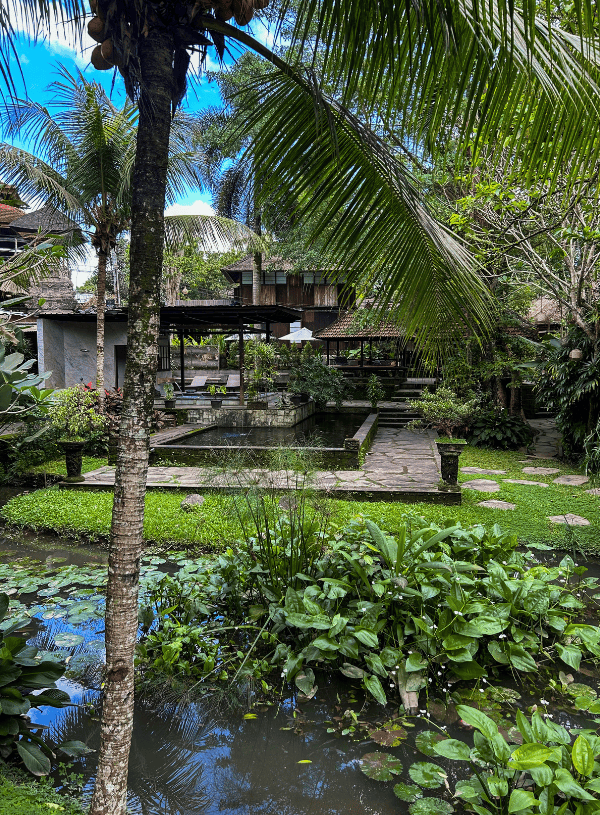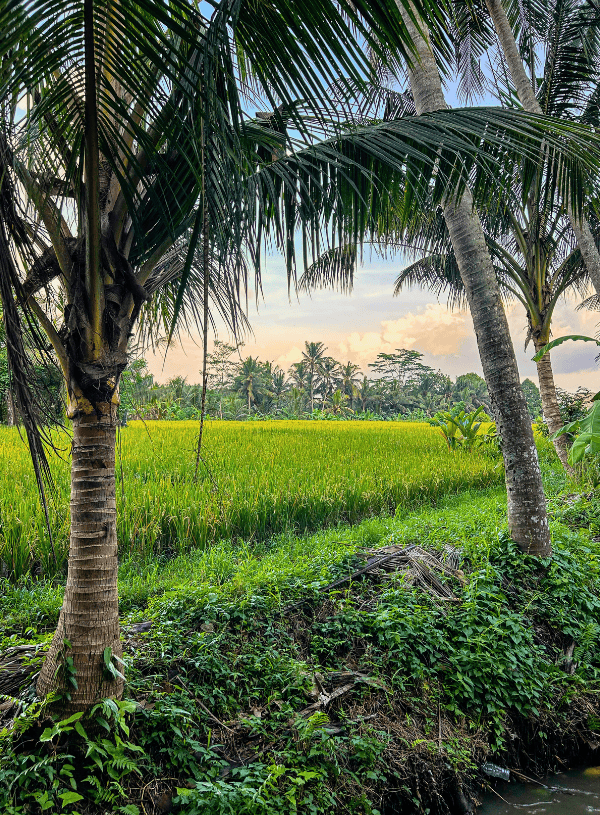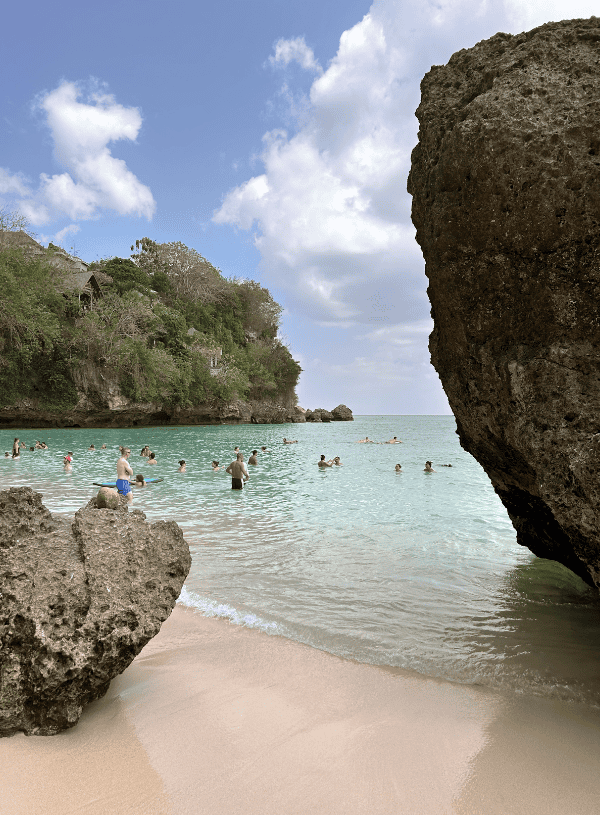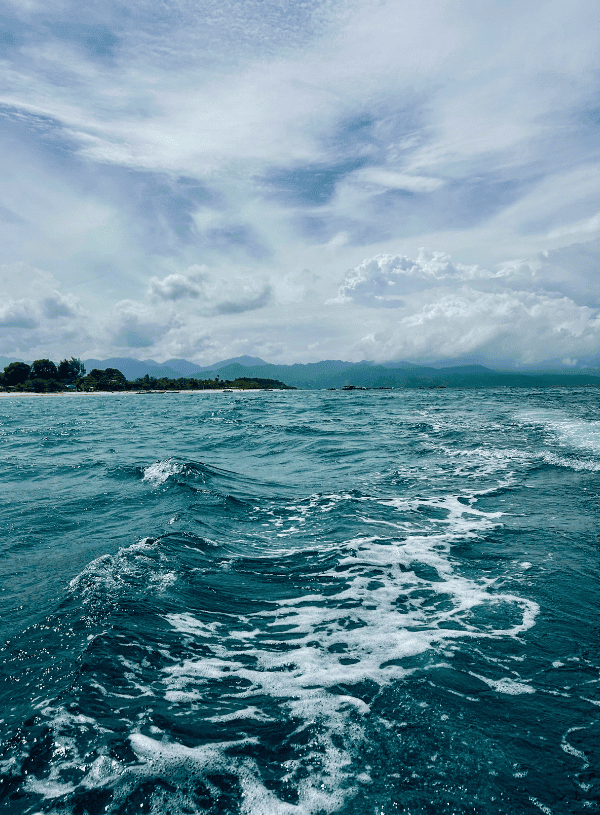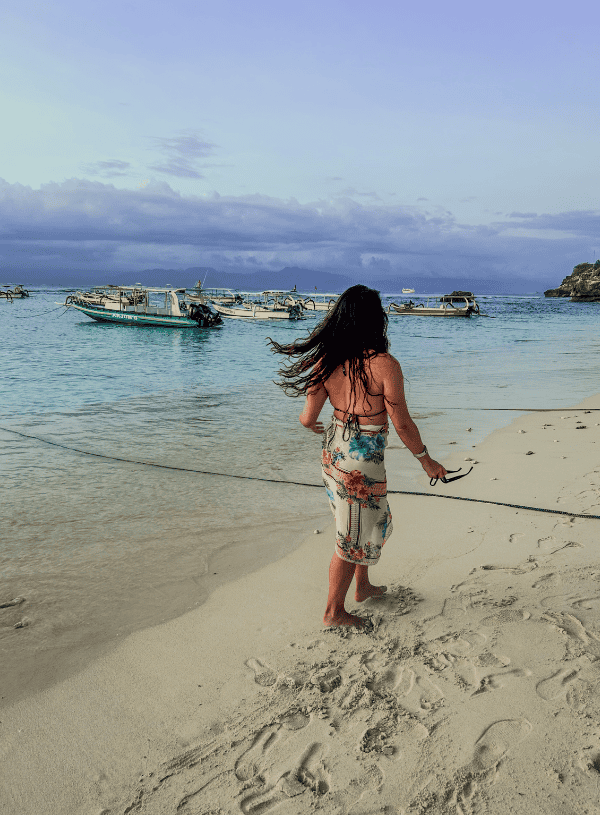Whitewater Rafting in Ubud: Best Tours, Tips & What to Expect
Last Updated on September 28, 2025
Are you already planning your trip to Bali and wondering if whitewater rafting in Ubud is for you? You’re in the right place and… spoiler: yes! Rafting is definitely one of the most fun activities you can plan while traveling here.
Usually, rafting in Ubud takes place on the Ayung River, a 2-hour ride covering around 11 km, where you’ll get to experience the beauty of the Ayung River Valley in a very unique way. Think deep jungle, thrilling (but manageable) rapids, and the most entertaining Balinese rafting guides.
So far, I’ve had two rafting experiences in Ubud with two different service providers. In this blog post, I’ll review the overall experience, guide you through which tour might be the best fit for you, and share some tips on how to prepare for your rafting adventure.
This article may contain affiliate links. This means that if you purchase through one of the links, I may be paid a small commission at no extra cost to you. Thank you for supporting the blog and allowing me to keep sharing meaningful travel experiences with you.
Don’t have time now?📌 Save it for later!
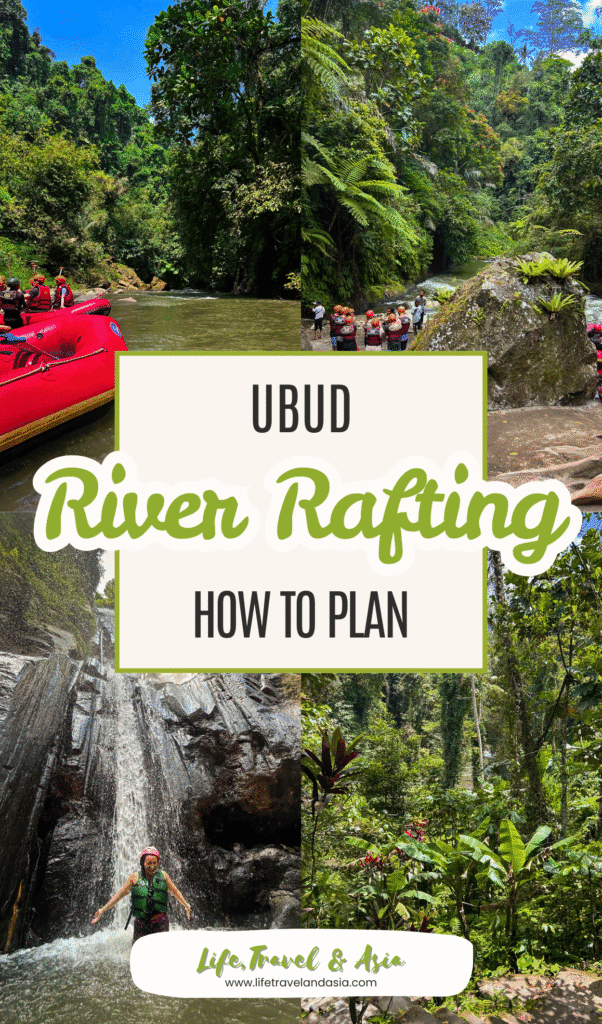
Recommended Rafting Experiences
Rafting in Ubud: What To Expect
Now that I’ve had a second rafting experience in Ubud, I can confirm that the overall experience is more or less the same.
Most rafting service providers in Ubud are based in the Kedewatan area, close to the river valley, which makes it easier to access the river.
All tours last about two hours, follow the same 11 Km route, and include lunch in the main ticket price.
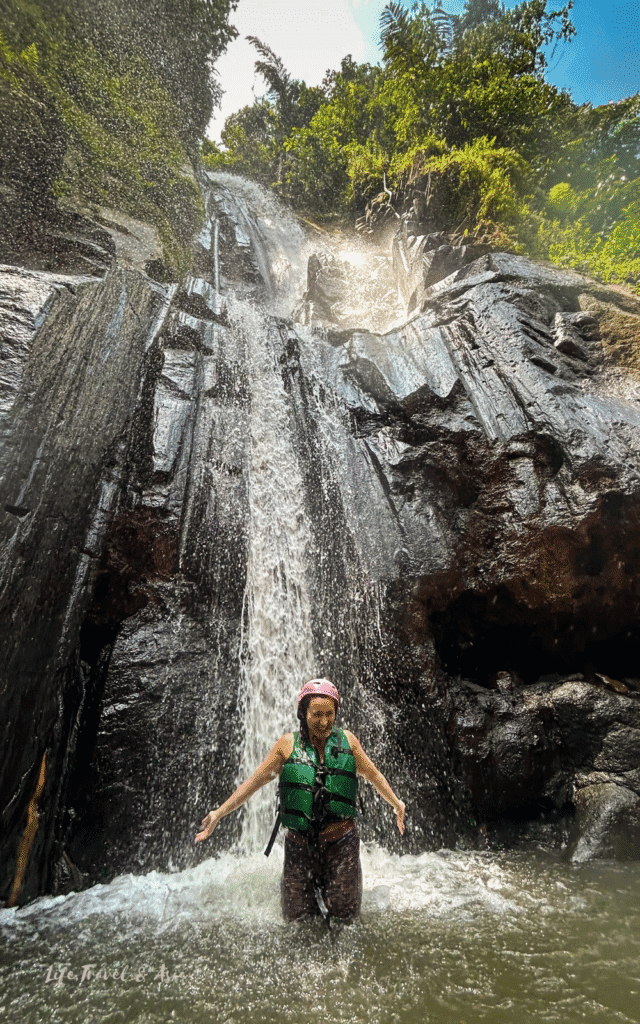
What really changes—and this may or may not matter to you—is the starting point of your rafting experience.
The path downhill (and of course uphill on the way back) to the river can be either longer or shorter. Unfortunately, there’s no real way to know in advance.
When I went with Graha Adventure, the path was longer, muddy, and very busy. On the other hand, the second time with Bali Bintang Rafting, the route was shorter, paved with stairs, and my group was the only one heading down to the river.
How To Get There, Gear & Preparation
Most tours on GetYourGuide or Viator include hotel pick-up and drop-off. If this isn’t included and you want to save some money, you can easily book a Grab bike to get there and back.
I recommend arriving at least 30 minutes before your rafting time. Once you arrive at the base, you’ll need to sign some release forms. You can store your belongings in a locker (usually requiring a cash deposit) or change in the provided facilities if needed.
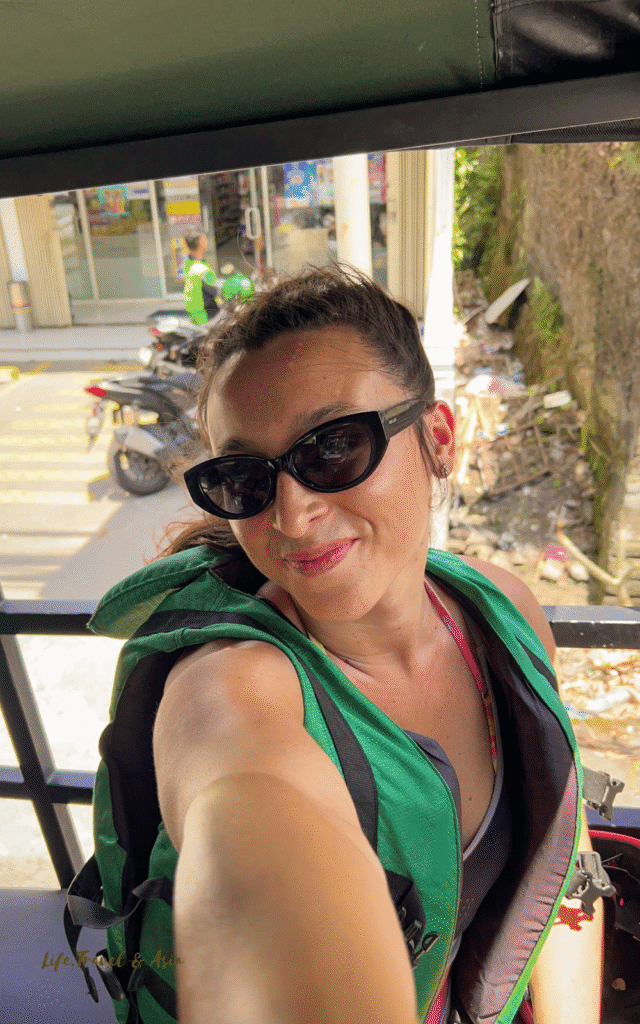
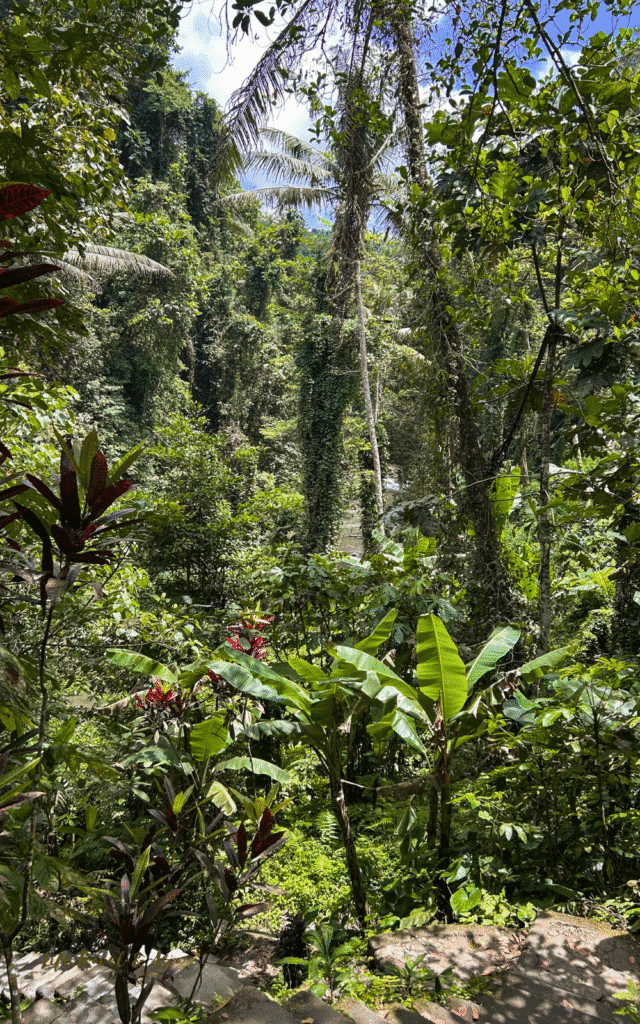
Big backpacks aren’t allowed down by the river, but you can choose whether to bring your phone or camera. Your guide usually carries a dry bag where you can safely store them.
When it’s time, the guides will give you a safety helmet, a life jacket, and a paddle. You’ll be asked to put them on right away, even though it usually takes some more time before you actually get on the raft.
Once everyone is ready, you’ll hop on an open cart with other participants to reach the drop-off point, where you’ll begin the downhill walk to the riverbank.
The Downstream Walk to the River
During my second rafting experience, I remember sitting on the cart thinking, “If only I could already be on the raft,” because I knew exactly what to expect.
The first time, with Graha Adventure during the rainy season, even the walk down to the river felt like an adventure: muddy paths, a never-ending line of people slowly making their way down, and that classic feeling of “if one slips, we’re all going down together.”
This second time, with Bintang Rafting, I was pleasantly surprised. The path was incredibly short—just 10–15 minutes—with no mud, only steep paved stairs (which, trust me, are just as challenging to climb back up after two hours of rafting). Best of all? No crowds.
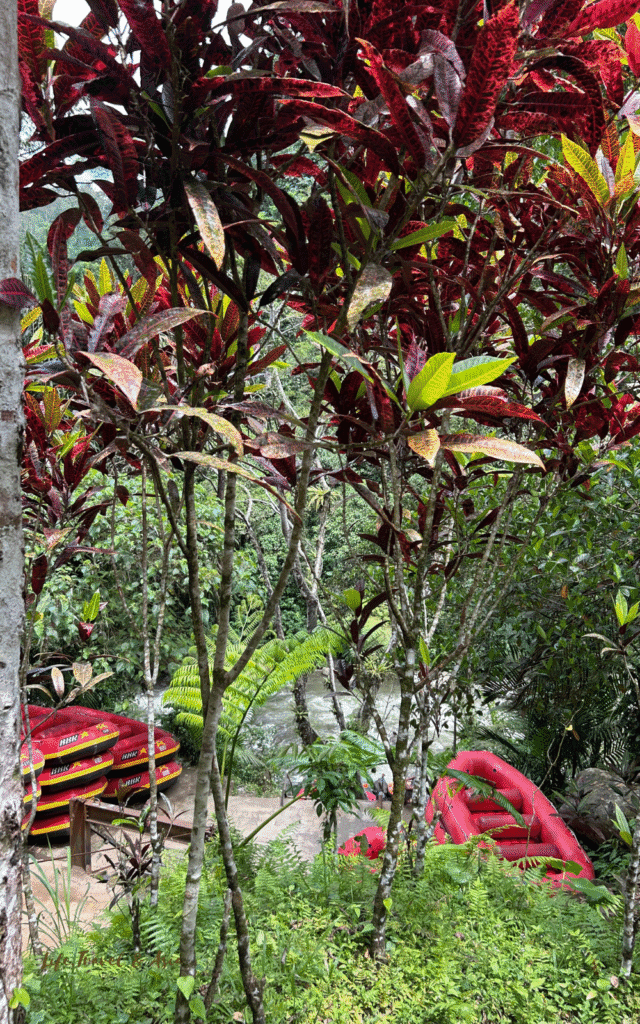
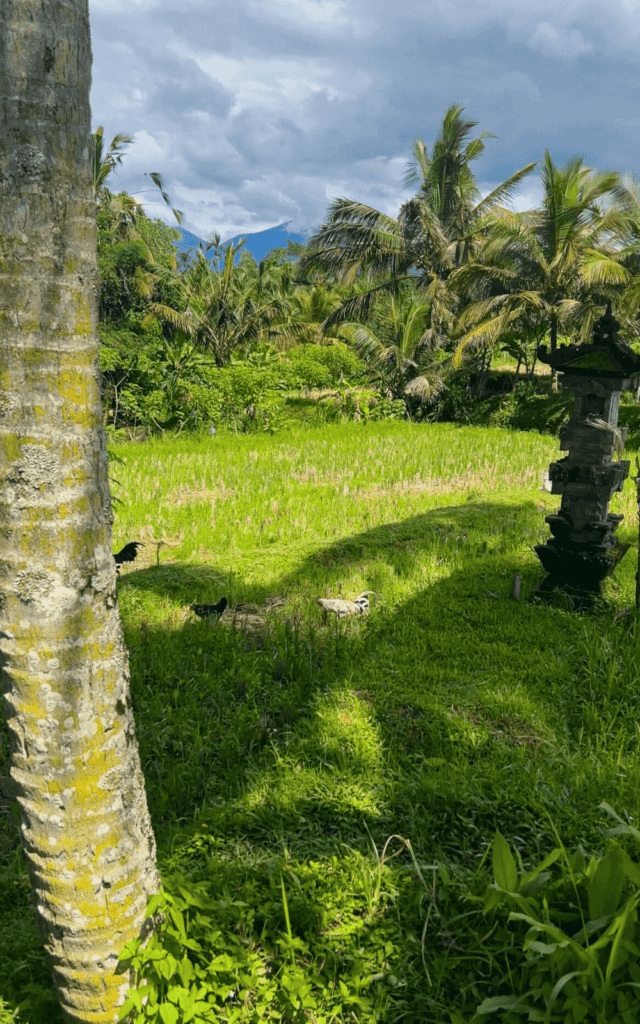
In both cases, you’ll be surrounded by dense jungle, towering trees, and the occasional animal peeking through.
Honestly, nature is the real highlight of the whole experience. The only downside is that you might regret putting on your helmet and life jacket so early—it gets hot, and there’s still a bit of waiting before the rafting actually begins.
In both cases, you’ll be entirely surrounded by dense jungle, towering trees, and the occasional animal peeking out. During the walk, you might regret putting on your helmet and life jacket right away, as there’s still some time before the rafting begins, and it can get hot.
The Rafting Experience Itself
Once you reach the riverbank, the guides will arrange for 3 to 6 people to board each raft, excluding the guide.
The rafting activity lasts about two hours and covers 11 km in what feels like the setting of a theme park attraction designed to recreate a jungle experience—only this time, it’s real life.
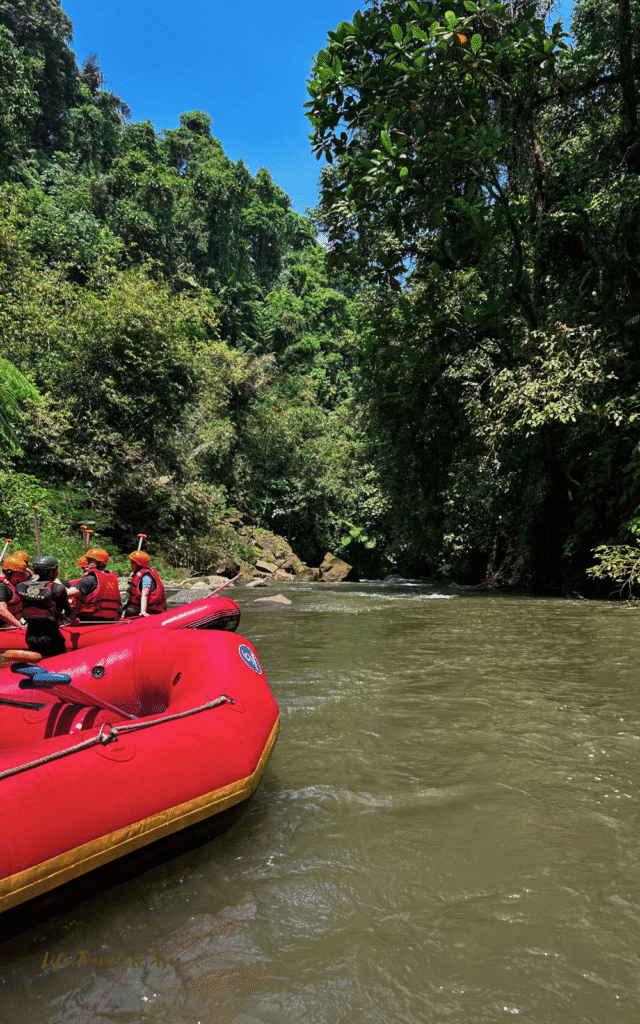
The Ayung River is the longest in Bali, and the section you’ll raft is perfect not only for first-timers but also for rafting experts.
Along the way, there are plenty of small challenges, from rocks where you might easily get stuck (and you will) to rapids providing “that” adrenaline rush and mini-waterfalls.
Pre-Rafting Instructions & Guides
Before setting off, the guides will teach you the four main commands they’ll shout at different points during the experience. This way, you’ll always know what to do in case of a sudden rapid.
Rafting is fun, but the Indonesian guides definitely make the experience even better. With their constant smiles and playful spirit, they’re completely unpredictable and can be hyper-competitive.
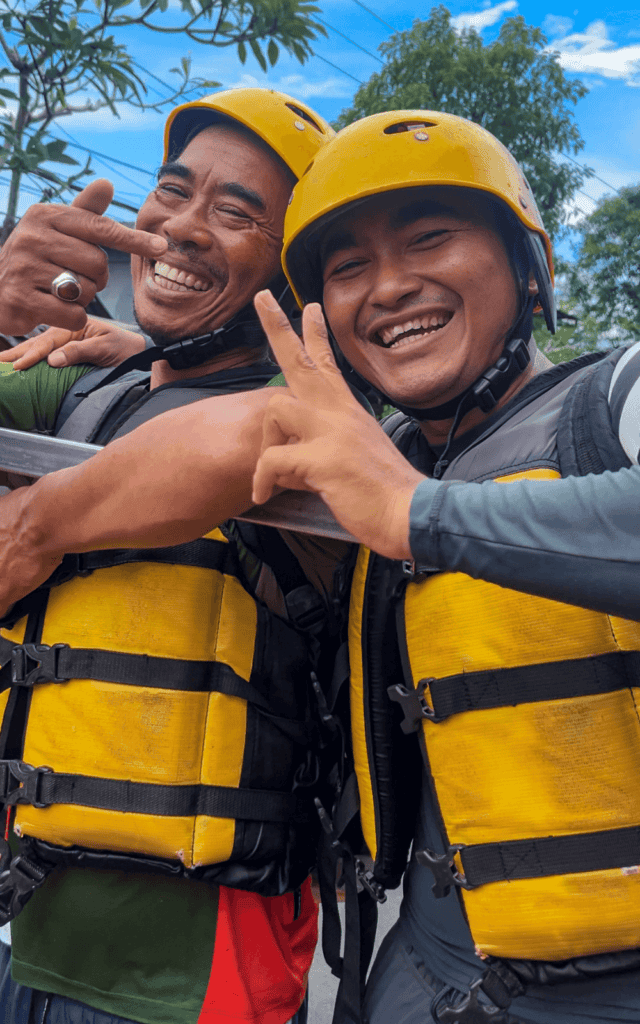
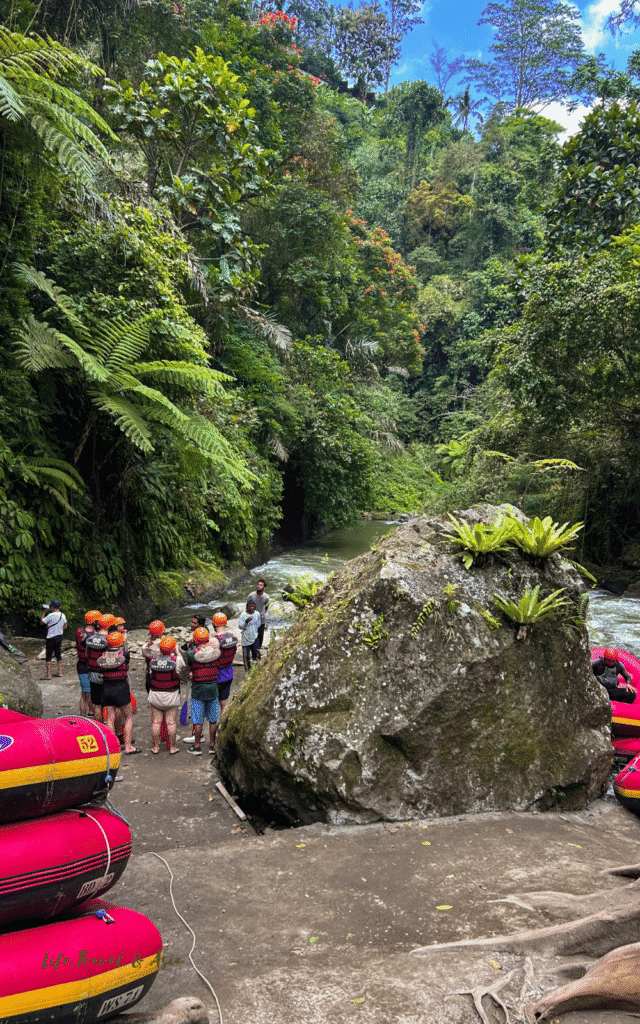
They might organize a raft race and do everything they can to get you stuck on a rock or block your raft (all while keeping in mind safety measures)
Views and Natural Beauty
During the rafting, about halfway through, you’ll have the chance to stop and take pictures under a mini-waterfall.
After the waterfall, you’ll stop at another point where you can refresh yourself with a coconut or other drinks. Then, the rafting continues for another hour until the endpoint.
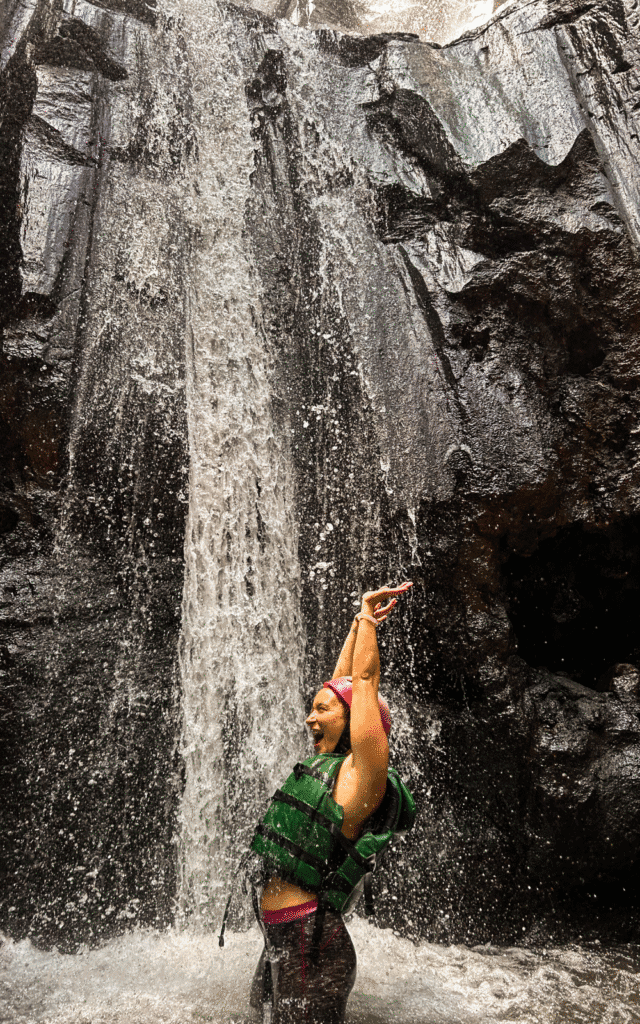
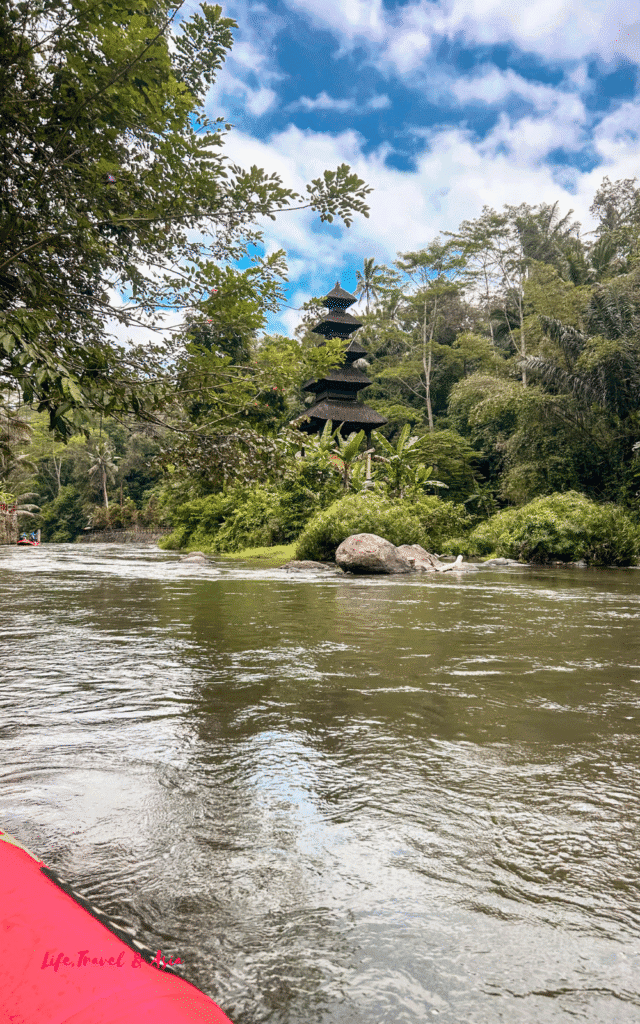
The scenery throughout the experience is unforgettable. The entire river valley opens before you, covered with lush, dense green trees. On the rock walls, you’ll notice centuries-old carvings, weirdly shaped trees, and other waterfalls flowing into the river.
Aside from the moments when you need to paddle or hold on because a rapid is approaching, you can relax for a few seconds and take in the views of the Ubud nature.
Post-Rafting Return
Once the experience is over, you’ll be pretty tired—let’s be honest, rafting is exhausting. You’ll need to return to the pickup point, which means retracing the same path you took earlier, but this time uphill.
Many dislike this part because, after two hours of rafting, another uphill climb isn’t exactly what you’d want to do.
Once you arrive, you’ll be taken back to base, where you can shower and change into dry clothes.
Things To Know About Rafting in Ubud
1. You’ll Get Wet
This is not just a possibility—it’s for sure! For the rafting itself, I suggest wearing leggings and a top with a bikini underneath. When it comes to shoes, you can go with sturdy flip-flops, water shoes, or sneakers that you don’t mind getting wet.
Once you’ve changed, you can enjoy the buffet included in the ticket price. The buffet exclusively offers Indonesian cuisine, and a separate payment is required for soft drinks.
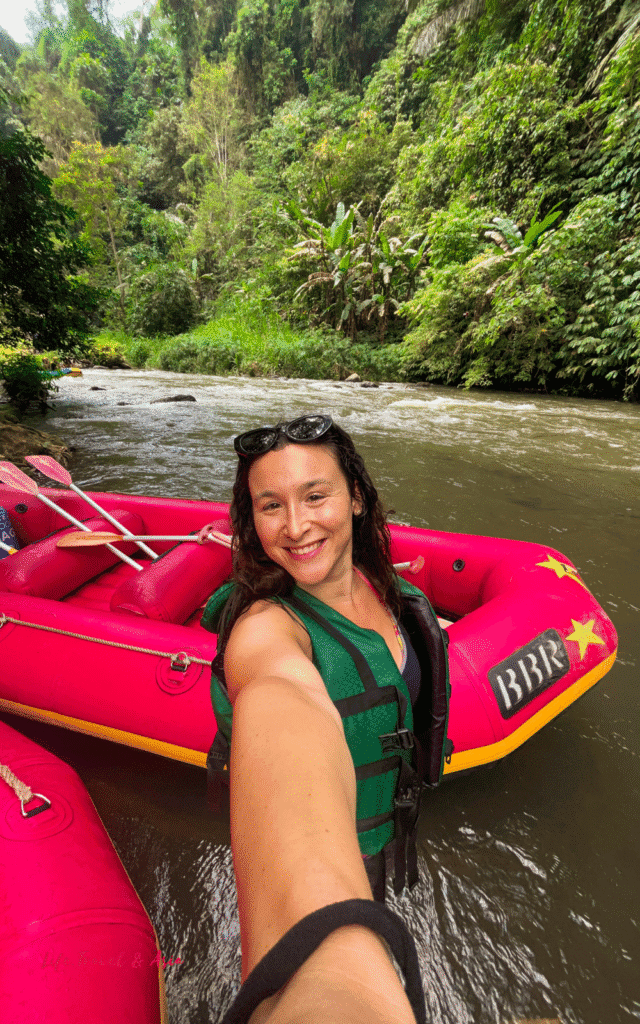
2. You’ll Have a Shower, a Towel & a Changing Room Available
After your rafting experience, all service providers give you the chance to change and take a shower at their facilities. They usually provide towels and bags for your wet clothes.
Remember to pack your shampoo and toiletries, because they’re not available in the changing rooms.
3. Big Backpacks Are Not Allowed on The Raft
If you still want to bring your belongings with you (despite the risk of getting them wet), you can use a small waist bag to store them. Rafting guides usually carry a dry bag where you can safely keep your phone.
4. Bring Cash
The locker deposit, guide tips, and any additional drinks you purchase at the stop during rafting must be paid in cash. So make sure to bring some small bills with you.
5. Tip for The Guide
They present it as if it’s just a suggestion, but in reality, it feels pretty much mandatory. So just so you know, tipping your guide is expected.
FAQ Section
1. What’s The Price For The White Water Rafting in Ubud?
The price is around IDR 450,000 or $27, including everything from transportation to the river to equipment, access to the changing rooms, and a lunch buffet.
Usually, tours offer a full refund up to 24 hours before the scheduled time, providing you with almost complete flexibility in case you need to change your plans (mainly due to weather)
2. Is Whitewater Rafting in Ubud Worth It?
Absolutely yes. I’m a first-timer, so I don’t have any comparisons to make, but it was one of the highlights of my very first trip to Ubud.
From what I’ve heard from more experienced rafters, rafting in Ubud is still fun and one of the best activities to try.
If you love nature and outdoor activities, you definitely won’t regret spending half a day surrounded by the sensational jungle of Ubud.
If you’re traveling solo, it’s also a great way to meet other travelers. You’ll be in a group on the rafts, and after an experience like this, where you share sweat, physical effort, and laughter, you might make some amazing friendships.
3. Are There Any Safety Tips for First-Time Rafters
As mentioned, whitewater rafting on the Ayung River is not particularly difficult.
The guides ensure that the commands are understood and executed correctly before setting off, and they are always attentive (even though they have a lot of fun themselves) to make sure participants feel secure. It’s definitely a safe experience.
Listen to your guide’s instructions
Their commands might sometimes seem counterintuitive based on what you see ahead, but trust that they know the river well and are guiding you safely.
Don’t Play With Your Phone
While it might be tempting to hold onto your phone for pictures and videos during the rafting, it’s safer to keep it stored in the guide’s dry bag. You’ll have plenty of opportunities to take pictures during the waterfall stop.
Hold On Tight
When not paddling, grip the safety rope attached to the raft. This will help prevent you from falling out during sudden movements.
Communicate with Your Guide
If you feel unsafe during the rafting experience, let your guide know. They are there to ensure you have the best possible experience and can make adjustments to enhance your comfort.
4. When is the Best Time to Go Whitewater Rafting in Ubud?
It may seem counterintuitive, but the best time to go whitewater rafting is right after the rainy season, when the river levels rise and water spills over the rapids.
However, I understand that planning a trip to Ubud during the rainy season may not be ideal.
To avoid days of heavy rain, consider visiting Bali right after the rainy season, in March or April. This can be the perfect time to enjoy the island’s best weather and high water levels.
Graha Adventure Vs. Bali Bintang Rafting Review
I’m usually not a picky traveler, but I do notice when things are done better. In this section, I’ll break down which service providers I preferred and in what aspects.
Base & Lunch
When I arrived at Bali Bintang Rafting, I immediately noticed that the base looked much neater and better organized compared to Graha Adventure. The lunch buffet also felt like an upgrade — even though there were fewer options, the quality was definitely higher.
At Graha, the buffet included only Indonesian dishes, while at Bintang Rafting, there was plain rice, juicy meat, cooked vegetables, spicy noodles, and fresh watermelon. Plus, they provided free drinking water.
Changing Rooms & Shower
Here, on the contrary, Graha Adventure does a better job. Their changing facilities are much bigger and better furnished.
At Bintang Rafting, there are only showers, and you need to get creative to hang your towel or bag. In both places, they provide clean towels.
Walk Downhill & Uphill to The River
This is probably the main reason I would choose Bintang Rafting over Graha. The walk downhill and uphill is much shorter (10-15 minutes vs 25-30 minutes), which is precisely what you want after a 2-hour rafting experience.
Plus, despite being steep, the paved stairs are much easier to manage than muddy terrain — especially during the rainy season.
There you go! Hopefully, now you know that rafting in Ubud is definitely your cup of tea.
If I had to do it again, I’d go with Bintang Rafting. But to be honest, I booked that tour the day before, totally at random, just picking the best-rated one on GetYourGuide…it was completely unexpected!
If you’re looking for more ways to connect with Ubud’s lush nature, here’s a list of my favorite things to see and do in town: hidden rice terraces, little-known corners, and plenty of fun activities you might want to try for the first time.
Did you find it helpful? 📌 Save it on Pinterest!
